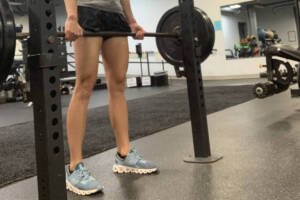With the popularity of downhill marathons, it’s not surprising that we need to learn how to RUN DOWNHILL properly. Because running downhill is not the same as running uphill or on flat ground in anyway.
Running downhill recruits different muscle groups and requires different form…and if you don’t do it correctly, running downhill can trash your legs and leave you limping to the finish.
My first experience with a downhill race
When I ran the Boston Marathon for the first time. I did zero reconnaissance on the race course; had no idea about the net downhill start or the ups and downs on Newton Hill; and foolishly thought there was one big hill in the whole marathon, Heartbreak Hill, that came somewhere around the proverbial wall.

Related: How to Avoid Hitting the Wall in the Marathon
So, I flew down the downhill with my body out of control—leaving my corral in the dust and catching up the pack in front of me. I didn’t even realize Boston had a new elevation loss of 350 feet. I just thought the race day vibes were really giving me a boost. But by the time I got to the uphills, my legs from my calf muscles to my quads were toast. I rode the struggle bus to the finish line.
So many runners make this mistake running downhill. They use the momentum and pick up the pace. But running downhill is harder on the body than running uphill so you literally have to pace yourself.
In this article, I share expert tips in how to run downhill so you can best prepare for a hilly race.
Related: Are Downhill Marathons Easier to Get a PR?
I will share:
- What happens to your body when you run downhill
- The correct form for running downhill
- How to not run downhill (top mistakes), and
- Top training tips for downhill races
Let’s roll!
Is it hard to run downhill?
Yes, running downhill is harder on the body than running flat because the ground impact is greater and so is the damage to your muscles, making you sorer. This soreness often shows up in Delayed Onset Muscle Soreness or DOMS—where it peaks about two days after your hilly race. You may have difficult going down stairs or sitting down.

Running downhill causes more microtears in your muscle fibers as your leg extends in front of you and absorbs the impact of gravity, explains exercise physiologist Todd Buckingham:
The eccentric contractions (lengthening of the muscle) required of running downhill creates more tearing of the muscles than concentric contractions (shortening of the muscle). This causes damage to all the working muscles including your calves and especially your quads. The increase in impact also taxes your core and back more, as well as your your feet since ground contact is longer.
Related: Should You Pop a Running Blister?
Also, think of running downhill as a form of resistance training. As you fight gravity, you put more load on your joints (from your ankle to knee to hip) and your muscles from your quads, quad/patella tendon, and anterior tibialis.
This means, running downhill without proper training and proper downhill running form can put you at greater risk for injuries including back pain, IT Band syndrome, ankle sprains, quad strains, plantar fasciitis, and knee pain.
Let’s not let that happen by going over good form for downhill running!
Related: The Ultimate Running Injury Prevention Guide
How do you run downhill effectively?
When running downhill, you want to not fight gravity but you also don’t want to be overtaken by it. Learning how to run downhill with proper form will protect you from injury, allow you to improve running performance, and put downhill running in your toolbox to get stronger. Here’s how to run downhill.
Downhill Running Tips
-
Take short, light, quick steps.
Lessen the force of gravity and extra eccentric loading of your muscles by shortening your stride length as you run downhill. If you try to maintain your normal stride and cadence, you’ll put too much strain on your quadriceps and knees as they try to keep you from failing forward.
Shorten your stride by aiming to keep your feet landing under you, beneath your center of gravity instead of in front of you. This will naturally allow you to quicken your cadence so you can maintain speed without burning your legs out.
Also, try to land lightly instead of letting your feet slap into the ground. Think “quick, light feet.” This will minimize the impact.
Related: How to Quicken Your Cadence
-
Lean forward.
While your shortening your stride, lean forward slightly instead of backward. A lot of people will try to fly down a hill with a long stride and keep themselves from flying forward by leaning back. Do not do this! If you have a slight forward lean while running downhill, you can maintain momentum without stressing your body out.
Do this by trying to ever-so-slightly leaning forward from the ankles. It’s not a huge lean, but enough to allow you to use the gravity to your advantage and protect your thighs and knees when you land.

-
Angle your feet.
If you’re going down super steep hills, the best way to keep from falling is to angle your feet to a diagonal. This is must for trail runners. This will allow you to get better traction. And if you have better traction, your body will move more fluidly, allowing you to run smooth. Running stiff won’t only hurt your performance but it can lead to running injuries. If the hill is really really steep, run zig zag to maintain control.
Related: How I Stopped Being Injury Prone
-
Look ahead.
Looking down at your feet can cause you to turn off your hamstrings and back muscles so that you aren’t working at full power. This increases your likelihood of falling. So try to look about a few feet in front of you. This allows your brain time to see what’s coming and adjust, and keep your body aligned and balanced.
-
Keep arms low.
If you’re running down a steep slope, keep your arms low and by your sides to help with added stability—think a bit less than an 90 degree bend. This allows them to help balance your body as you let gravity move you along.
How should you not run downhill?
As I hinted, there IS a right way and wrong way to run downhill. Here are the top downhill running mistakes.
Top Downhill Running Mistakes
- Overstriding. Don’t be like foolish Whitney in Boston and run down the hills as fast as possible. It can be tempting, I know. But doing this will lead to over-striding where your foot lands in front of your knee and body. And this can lead to injury.
- Heel striking. Avoid using your heel as a brake when you traverse downhill. Instead, try to land more midfoot.
- Tensing up. While you don’t want to fly down the hill out of control, you also don’t want to tense up and fight the force of the hill. Instead, aim to run controlled, using the momentum to your advantage but not being overtaken by it.
- Not adjusting your form. If you try to maintain the same running form downhill as you do running flat, you will likely get hurt at some point. Aiming to shorten your stride, leaning slightly forward, with arms down, and feet angle to the side, will allow you to maintain control while still move forward quickly. Also, if you look down at your feet instead of a little ahead like most people want to do, you increase your risk of falling.
Okay, now that we know how to run downhill correctly, how do we train for downhill races? I got you covered.
Related: How to Fix Your Form
How do you train for downhill runs?
You train for downhill runs by gradually including downhill running in your training while readying and strengthening the body to do so. Here’s how.
Downhill Training Tips

As your training would change for a flat or hilly marathon, so too, should your training change for a downhill marathon.
Practice running downhill.
Gradually increase downhill running into your running routine, starting with a gradual slope of -2 and -5 percent, progressing to a -10 gradient. A gradual start of hill workouts will reduce the risk for injury and also optimize recovery. Also, don’t spend a lot of time a week training hills. One session once per week is enough.
- I recommend doing this first with as little as 4 downhill repeats of 50 meters at the end of 1-2 easy runs a week. You can add more repeats after 2 weeks of this.
- Once you get up to about 8 repeats comfortably (or 4-6 weeks of downhill repeats), you can incorporate weekly workouts of just downhill repeats aiming for a set number of reps (like 10 of 100 meter downhills) or time (20 minutes of hill work once per week, for example).
- You can also include “hilly route” runs where you practice running downhill during a normal run.
- Incorporate downhill sections into your long runs and training run that mimic the terrain of your race.
- Avoid steep downhills during taper before a big run.
I recommend starting on soft surfaces to minimize impact. Be kind to yourself when doing this. You will experience exercise-induced muscle soreness, this is why you should do a hill workout only once per week at most. And, note it will take practice to perfect your downhill running form.
Lift for downhill running.
Strength training is crucial for a runner’s health and performance. If you want to be the best runner you can be, you should be strength training at least twice per week for 20-60 minute sessions. If you want to be the best downhill runner you can be, you should incorporate specific types of strength training:
Related: The Ultimate Strength for Runners Guide
-
Eccentric exercises.
Focus on slow moves where it takes about 5 seconds to extend (or lower) the working muscle, and then you pop back up. These eccentric muscle contractions perform what’s called a repeated bout effect. This isn’t completely understood, but the eccentric loading in the weight room can adapt the muscle to protect it from damage in subsequent eccentric muscle actions on the roads and trails.
Try this for the follow strength exercises:
- squats
- Bulgarian split lunges
- reverse Nordic curls, and
- calf raises
-
Lift heavy.
Once per week, lift with heavy weight and low reps (4-6 reps) for 3-4 sets with 2-4 minutes of rest in between. You can do the moves above for this plus Russian Dead Lifts.

-
Plyometrics.
In another lifting session per week or sprinkled into the heavy lifting or eccentric loading lift session, do plyometrics. These explosive exercises active the fast twitch muscles and give you fast, responsive strength.
Some plyometric exercises I like for runners include:
- Frog jumps
- Jump squats
- Burpees
- Split squat jumps, and
- Skater Hops
Related: 8 Best Plyometric Moves for Runners
-
Stair work.
Leveraging the stairs in your house can provide an amazing workout for running downhills. Some workouts include:
- step-ups (quickly starting with 30 on each leg and building to 100)
- step-ups with weight
- single let hop into stair
- running downstairs
- double leg hop onto stair, and
- stair touches
I love amazing running coach Davide Roches’ workouts that incorporate these step strengthening exercises:
Related: How to Lift for the Marathon
-
Running drills.

Running drills will help you run downhill effectively.
Drills for runners help your body stay mobile and increase the body/brain connection, allowing your body to efficiently move. Drills I like are:
- high knees
- side shuffle
- A-Skip
- B-Skip
- butt-kicks
- straight leg bounds
- backward running
- high knee butt kick, and
- carioca
Do each drill for 20 meters two times a week after a warm-up. Watch my video of running drills here. View these drills here.
Related: 8 Running Drills for Runners
Have proper gear.
Also, make sure you are wearing running shoes that are cushioned like the Hoka Rincon or Hoka Bondi, or a carbon fiber shoe.
Related: Best Hoka Running Shoes for Long Distance
If you are running trails, make sure you are wearing good trail shoes with good grip. This will all help absorb the impact and minimize the risk for falling.
Also, consider applying anti-blister gel like Body Glide to your feet and use good anti-blister socks.
Related: The Best Anti-Blister Running Socks Around
Pace smart.
Lastly, be sure to have a smart pacing plan if you are running a race with a lot of downhills. Be sure to take the downhills on the front end very conservatively. Try to maintain effort over pace on the uphills. And, finally, avoid trying to bank time on hills.
That never works.
If you want guidance with your running goals, including downhill race goals, check out my run coaching services. Also, be sure to check out my free training plans:
- Postpartum Training Plan
- After a Break Training Plan
- 5k Training Plans
- 10k Training Plans
- Half Marathon Training Plans
- Marathon Training Plans
- Strength Training Plan

